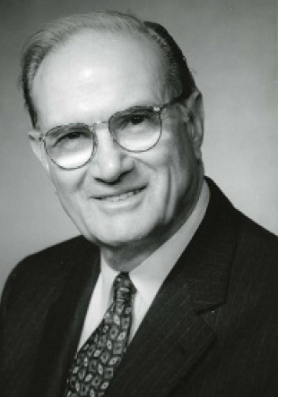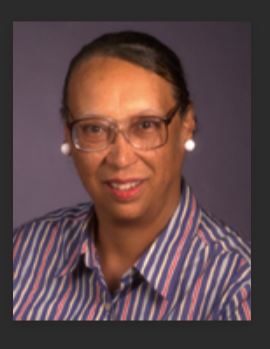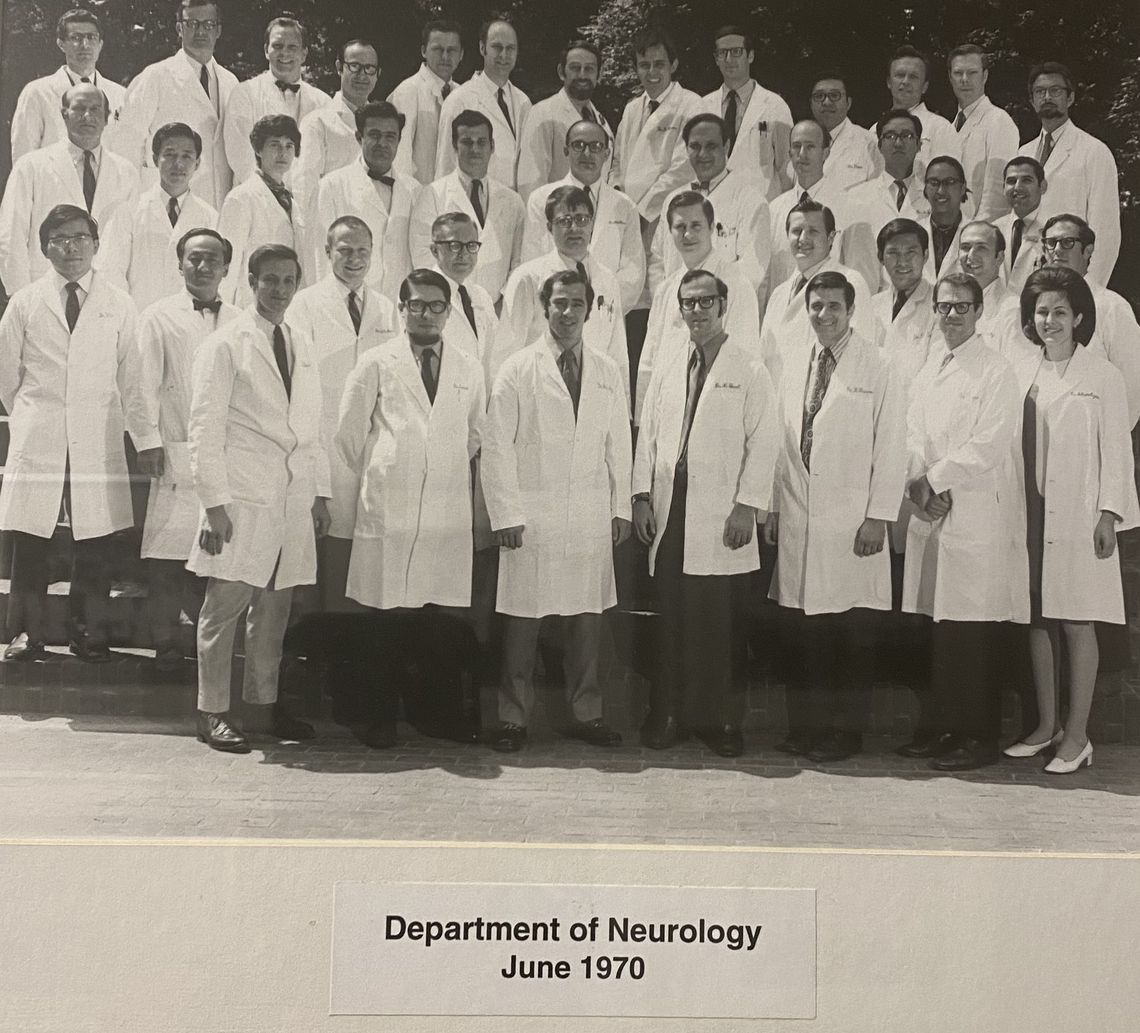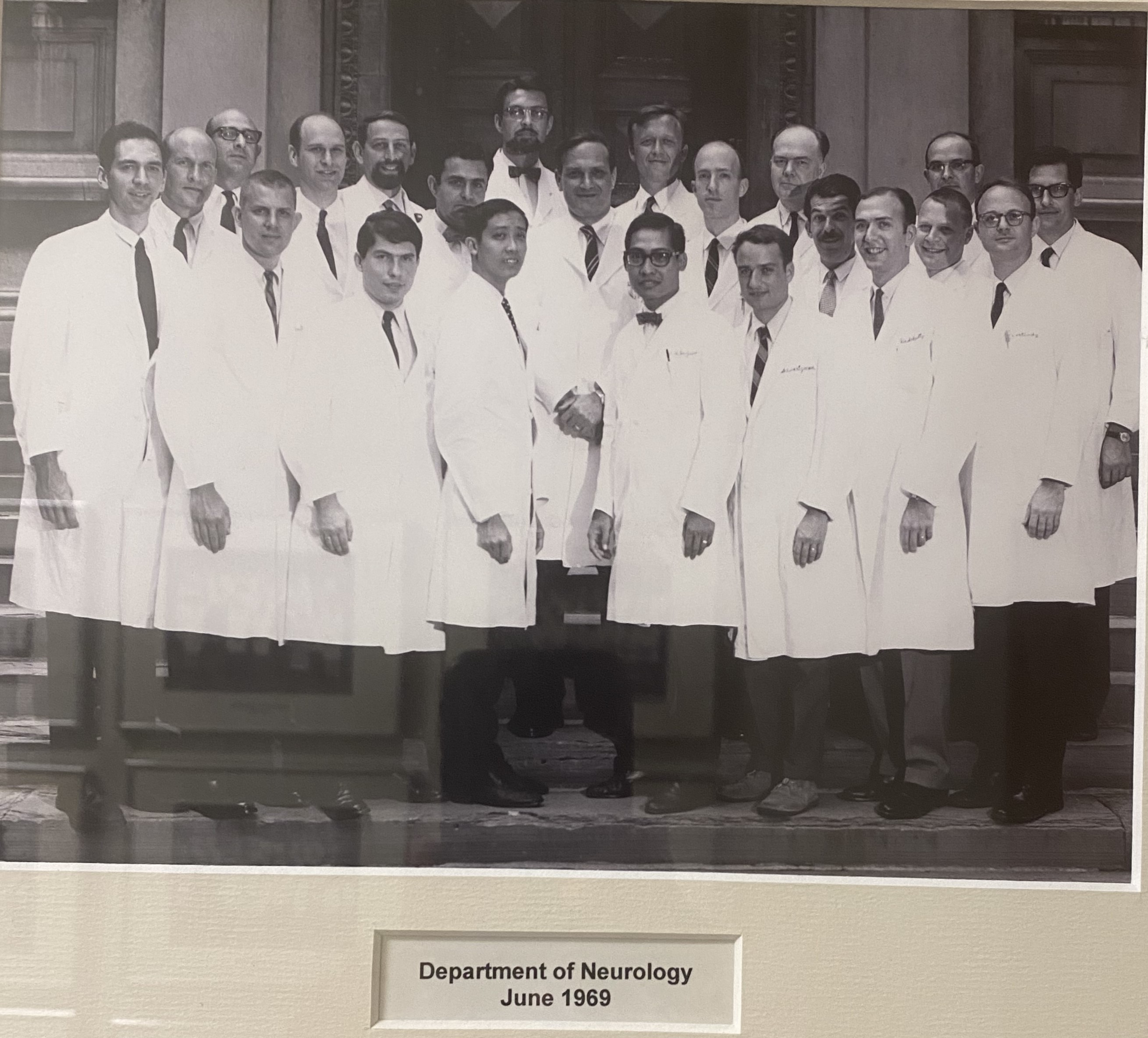- Our History
- The History of Neurology and Timeline
- Timeline
- Lewis R. Rowland, Chair
FACULTY INTERVIEWS
Dr. Howard Hurtig interviews Esther Rowland (wife of Dr. Rowland): Check out Esther Rowland talk about her early years: Check out the full video here: Esther Rowland
Dr. Howard Hurtig interviews Dr. Stanley Fahn: Listen to Stanley Fahn talk about why he studied medicine: Check out the full video here: Stanley Fahn
Lewis R. Rowland, Chair, 1967 — 1973

Dr. Rowland’s primary interests were in the biochemical basis of muscle diseases, and in amyotrophic lateral sclerosis. In 1970, the Watts Muscular Dystrophy Research Center was developed, one of the first recognized by the Muscular Dystrophy Association. When he moved from Columbia to Penn, he brought with him Drs. William Bank, Eduardo Bonillo, William DiMauro, and Audrey Penn, all focusing on neuromuscular disorders, and Stanley Fahn, who developed his interest in movement disorders as L-Dopa became available. When Dr. Rowland returned to Columbia in 1972, Drs. DiMauro, Fahn and Penn returned to New York with him.

at the University of Pennsylvania Neurology
Department and first to achieve tenure.
Notably, Dr. Penn was the department’s first African-American faculty member, promoted to Associate Professor before her return to Columbia University. She was also the department’s first woman to achieve tenure. (See photo on left).
At Penn, Dr. Rowland recruited Drs. David Pleasure and Leon Prockop, primarily for the Neurology service at Philadelphia General Hospital, and Peter Berman to head Child Neurology, joining Sam Tucker at CHOP’s original site at 18th and Bainbridge Streets. Other faculty recruited included Drs. Donald Gilden, neurovirologist who linked HUP Neurology with the Wistar Institute, Richard Harner, who began the development of neurology and a focus on epilepsy at Graduate Hospital, Howard Hurtig and William Masland at HUP. Dr. Pierluigi Gambetti and Kuniko Suzuki joined Dr. Nicholas Gonatas in Neuropathology, joint appointments with the Department of Pathology.
These faculty additions complemented the existing full-time faculty, Drs. Martin Reivich and Donald Silberberg, and the very active clinical faculty members, Drs. John Bevilacqua, Geraldine King, and Gabriel Schwarz.
In 1967-1968, the adult training program included seven residents and one fellow. The program was expanded to three, and later four residents/yr. Child Neurology trained two/yr., each of whom spent their first year at HUP.
The 20-bed inpatient until remained on Ground Floor Gibson. HUP’s capacity in 1967 was 650 beds. Neurology’s outpatient visits totaled 3,175 in 1966-1967.
At the time of Dr. Rowland’s return to Columbia in 1973, the faculty included 27, including 23 at HUP and PGH, two at CHOP, one at Pennsylvania Hospital, Dr. Frank Elliot (recruited in 1959) and 2 in Neuropathology. Residents numbered 25, and Fellows 12.
During these five years, programs were developed that laid the foundation for their later designation as ‘divisions’ of neurology. Dr. Martin Reivich established the Cerebrovascular Research Center and obtained funding to install a cyclotron dedicated to producing radionuclides for PET scanning. Drs. Hurtig (as a resident), Reivich and Silberberg were the stroke service, helping vascular surgeons to identify candidates for carotid endarterectomy, and seeing stroke inpatients in consultation on other services at HUP. The Multiple Sclerosis Clinic, staffed by Dr. Silberberg, joined by Dr. Robert Lisak while still a resident, saw 400 patients/yr. Drs. Alan Laties (Ophthalmology) and Silberberg established a Neuro-Ophthalmology Clinic with the help of both Neurology and Ophthalmology residents, and organized teaching for both departments. The major focus on neuromuscular disorders continued Penn’s leading role in this subspecialty nationally. Dr. Fahn’s interest in Parkinson disease dovetailed with the FDA’s approval in 1969 of levodopa as a revolutionary new treatment for PD. By 1970, the demand for levodopa treatment was enormous, and Penn’s flagship Hospital of the University of Pennsylvania (HUP) was flooded with severely disabled parkinsonian patients—thanks to Dr. Gabriel Schwarz’s large private practice—most of whom responded dramatically to the slow introduction of a drug that, unlike all previous pharmacotherapy for PD, restored many of them to a state of independent function. It is significant that it was Dr. Rowland who suggested to Dr. Fahn that the rapidly expanding program for treating these patients be named the Division of Movement Disorders, the first of its kind in the US. With the help of the residents, Drs. Fahn and Schwarz directed the care of as many as 25 inpatients at a time during an average stay of 1-2 weeks while levodopa was being slowly introduced. Scroll down to find the link to the Department group photos in the "People of this Era Spotlight box".
In addition to his clinical and scientific expertise, Dr. Rowland was admired as a teacher and for his sense of humor. At grand rounds and other conferences, he would usually sit in the first row, appear to fall asleep, and at the conclusion of the presentation raise his hand and ask a penetrating question. As Dr. Rowland listened to student and residents’ presentation of patients’ histories, he consistently objected to stating the patient’s race, unless it was closely linked to the patient’s illness, such as sickle cell anemia. He also objected to the use of the gender identifiers male and female instead of the more appropriate man, woman, boy and girl.
Dr. Rowland, and his wife Esther, were avid anti-Vietnam War activists. At one point, he was on the verge of traveling to Hanoi with Jane Fonda, demurring out of his sense of responsibilities in Philadelphia.
References and Sources:
Major Discoveries and Events at Penn during this time
- 1967 - Penn adopted an “Admissions Policy for the Undergraduate Schools of the University of Pennsylvania,” chaired by Dan M. McGill, thereby committing the University for the first time to increased recruitment, retention, and promotion of minority students, faculty, administrators, and Trustees.
- 1971 - A news release announced, “University of Pennsylvania president Martin Meyerson names James H. Robinson to the newly created position of Equal Opportunity Administrator at the University….Mr. Robinson will be responsible for preparing and maintaining a University Affirmative Action Plan to ensure equality for women and members of minority groups. He will also assist various departments in preparing Affirmative Action Plans of their own and will monitor the implementation and execution of the departmental plans as well as the overall University Affirmative Action Plan.”
Major Translational Research and Clinical Advances during this era
- Dr. Martin Reivich established the Cerebrovascular Research Center.
- Dr. Reivich obtained funding to install a cyclotron dedicated to producing radionuclides for PET scanning.
- Dr. Donald Silberberg’s laboratory studies established the basis for phototherapy for kernicterus (bilirubin encephalopathy).
- Dr. Penn was the department’s first African-American faculty member.
People of this era
|
Neurology Faculty
|
Neurology Faculty (continued)
|
Neuropathology
Emeritus Professors
|
|
Residents
|
Residents (continued)
|
Fellows
|
See Department Photos from this Era


